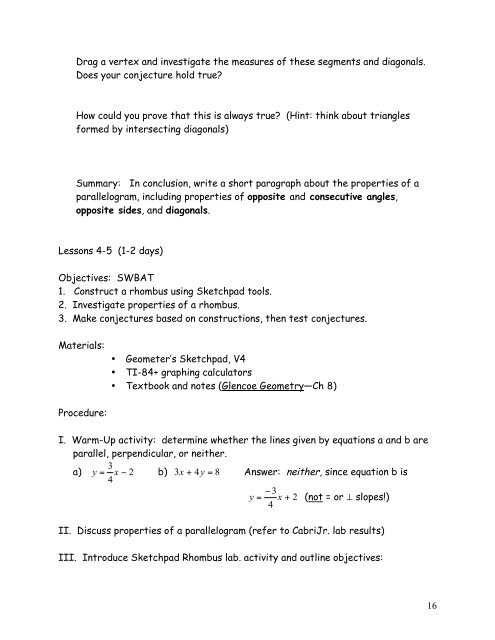Discovering Discovering Parallelograms Parallelograms
Discovering Discovering Parallelograms Parallelograms
Discovering Discovering Parallelograms Parallelograms
You also want an ePaper? Increase the reach of your titles
YUMPU automatically turns print PDFs into web optimized ePapers that Google loves.
Drag a vertex and investigate the measures of these segments and diagonals.<br />
Does your conjecture hold true?<br />
How could you prove that this is always true? (Hint: think about triangles<br />
formed by intersecting diagonals)<br />
Summary: In conclusion, write a short paragraph about the properties of a<br />
parallelogram, including properties of opposite and consecutive angles,<br />
opposite sides, and diagonals.<br />
Lessons 4-5 (1-2 days)<br />
Objectives: SWBAT<br />
1. Construct a rhombus using Sketchpad tools.<br />
2. Investigate properties of a rhombus.<br />
3. Make conjectures based on constructions, then test conjectures.<br />
Materials:<br />
• Geometer’s Sketchpad, V4<br />
• TI-84+ graphing calculators<br />
• Textbook and notes (Glencoe Geometry—Ch 8)<br />
Procedure:<br />
I. Warm-Up activity: determine whether the lines given by equations a and b are<br />
parallel, perpendicular, or neither.<br />
a)<br />
3 y = x ! 2<br />
4 b) 3 x + 4y<br />
= 8 Answer: neither, since equation b is<br />
! 3<br />
y = x + 2 (not = or ⊥ slopes!)<br />
4<br />
II. Discuss properties of a parallelogram (refer to CabriJr. lab results)<br />
III. Introduce Sketchpad Rhombus lab. activity and outline objectives:<br />
16

















